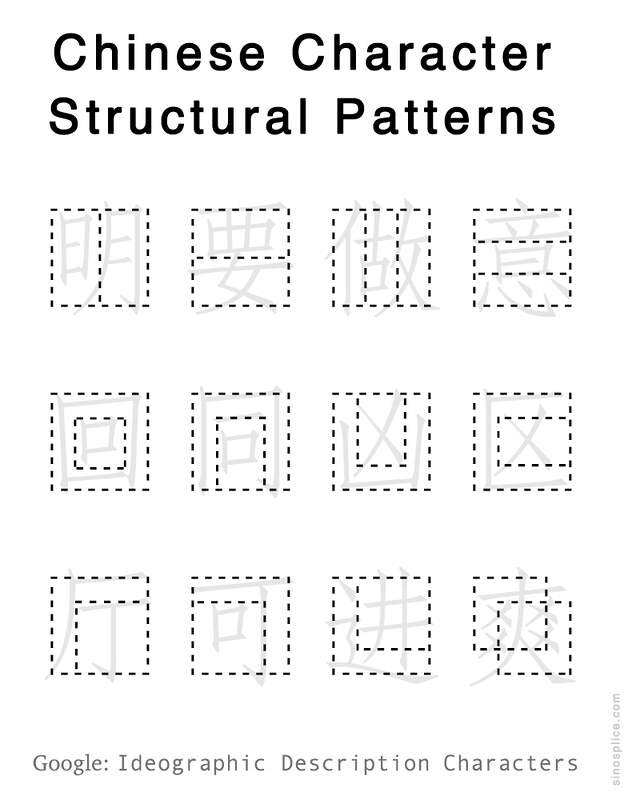Learn the Structural Patterns of Chinese Characters
It’s hard to succinctly explain what I mean by this title, because “character structure” and “character composition” are pretty much always used to mean “the character components that make up a character” (or, to use the more outdated term, “radicals”). But the character components would be the content. The limited number of spatial configurations in which those components routinely combine are the “character structure patterns” I’m talking about in this post.
Take a look at this:
If that’s not clear enough, let me break it down for you.
First of all, these “structural patterns” of Chinese characters are referred to as “Ideographic Description Characters” in the IT world, and each one actually has its own Unicode character! So you can copy and paste them just like other text (provided you have Unicode support), and even Google them. (Pro tip: Baidu them. Baidu Baike (Baidu’s Wikipedia) has lots of examples of each type.)
Here are those 12 Unicode characters:
⿰, ⿱, ⿲, ⿳, ⿴, ⿵, ⿶, ⿷, ⿸, ⿹, ⿺, ⿻
The patterns ⿰ and ⿱ (and sometimes a combination of those two, one embedded in the other) make up the most characters. Here are some simple examples of characters that use the more common structural patterns:
- ⿰: 明、昨、休、没、给
- ⿱: 名、要、想
- ⿲: 做
- ⿴: 四、国、回、困、田
- ⿵: 同、网、向
- ⿸: 广、病
- ⿺: 进、运、远、近
My advice is:
- If you’re learning characters, learn these patterns. There aren’t that many, and they’re useful. It’s also good to dispel the notion that character components can be combined in an infinite number of ways. It’s a lot to absorb, for sure, but it’s not an infinite number of options you’re dealing with.
- If you’re teaching characters, teach these patterns (or at least point them out) as you teach the character components. Everyone teaches components, but it’s nice to add a little structure to the teaching of structure. Confirm the growing, amorphous familiarity your students are acquiring, and give it a definite form.
- If you’re building a website or app, include these patterns. It’s not going to be useful to look up characters in this way, but if done right, it could be a great way to explore a character set, and self-directed exploration is one of the best ways to learn.


The final one is odd in that the character has horizontal symmetry but the “structure pattern” does not.
Yay, someone found a use for obscure unicode characters!
What are more examples of the 12th Structural Pattern? The example given (shuǎng) does not clearly show this make-up.
The key to the 12th pattern is that the two parts overlap somewhat. So in 爽, you have the character 大 with these weird X things on either side of it.
If you Google ⿻, you can find the Baidu Baike page: http://baike.baidu.com/item/%E2%BF%BB
On that page, some of the examples given are: 七、大、丰、必、夹、串、果、臿、乘、爽、噩、譱
I admit, some of those (like 果) are a little confusing, and you’d have to really study the evolution of the character to understand what’s really going on. But others, such as 必, are pretty straightforward.
Hi John! Amazing post and awesome blog! I lived in China for a couple of years, but unfortunately didn’t find enough strength to learn Chinese. 🙁
Anyway I do know some Chinese characters, as I like to do shopping on taobao. I’ve never thought the characters could be structured in the way as you describe. This makes things much easier with learning Chinese!
[…] When you break down the character 设, you can break it into “left-right” structure (⿰) first, giving you 讠 and 殳. Then 殳 can be further broken down as a top-bottom […]
[…] This is a good example where being familiar with the structural patterns of Chinese characters is useful. What I originally assumed to be ⿰ (with a ⿱ embedded on the right side) was actually […]